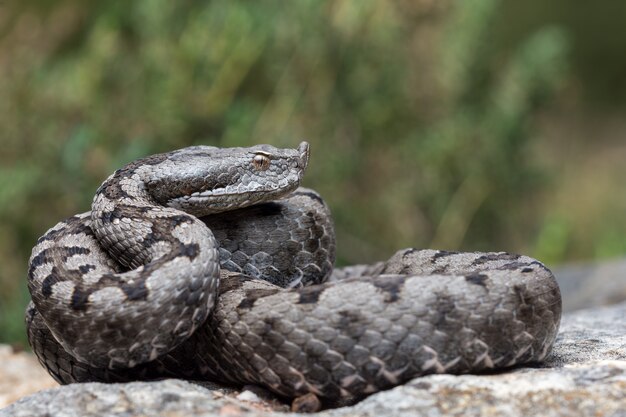The Vipera Latastei (Lataste´s viper) inhabits the Iberian Peninsula and North Africa. It is found throughout the entire Iberian Peninsula except for a narrow strip that runs along the north from the extreme west of Galicia to the extreme east of Catalunya. In the African continent it is found in Morocco, Algeria and Tunisia.

Description
It is a small snake, with an average length of 50 to 60 cm. (20-25 inch), only rarely some specimens may reach up to 75 cm (30 inch).
The head has a triangular shape and is clearly separate from the rest of the body. The most remarkable feature in this species is the upturned snout.
The dorsum of the head shows various degrees of ornamentation, nevertheless, two crescent moon shaped marks are almost always present. A dark postocular stripe is present on both sides of the head, which runs from the eye to the angle of the jaw.
Unlike most colubrids, which have an eye with a round pupil, the Lataste´s viper has an elliptical pupil, which it always keeps in a vertical position. The top of the head is covered with small scales, although some specimens show traces of a frontal scale and very rarely of reduced parietal scales.
From the neck to the tail the body is covered with small scales called dorsal scales. All the dorsal scales are keeled except for the first row on either side of the body. The under side of the body or belly is covered with ventral scales (from the gular region to the vent) and subcaudal scales (tail).
The dorsal pattern of Vipera latastei is similar to that of other European vipers; consisting of a wavy vertebral stripe or zigzag which is darker than the body ground colour.
Biology
Like other reptiles which inhabit regions with a temperate climate, the Lataste´s viper goes through a prolonged period of activity and a period of hibernation throughout the year. Activity begins when temperatures soften around mid-March, and it extends until the end of October when temperatures start to decrease, announcing the coming of winter.
Every year during the activity period the vipers feed periodically. The adult specimens shed their skin once or twice each season (juveniles shed more often) and they go through their reproductive cycle.
With the coming of winter vipers hide underground, using burrows and tunnels where they spend all the winter hibernating in a lethargic mode. During the 4 - 5 months of hibernation the vipers remain practically motionless and do not feed.
Diet
The Lataste´s viper is a diurnal predator which lies in wait for prey.
The viper uses its venomous apparatus to kill the prey. Adult specimens feed primarily on small rodents, completing their diet with lizards, birds and invertebrates (centipedes, scorpions, etc).
On the other hand, juveniles feed mainly on lizards and invertebrates (crickets).
Mating Habit
Some weeks after the hibernation period is over the vipers get involved in an intense courtship in which the males try eagerly to copulate with the females.
Copulations normally take place between the end of April and the end of May. Gravid females go through a gestation of three months, which may be a bit longer for the Vipera latastei gaditana subspecies.
By the end of August three to twelve baby vipers are born in a labour that lasts between two and three hours. Newborn vipers shed their skin right after birth. The reproductive cycle takes place every second year, while in the cooler regions it may even be triennial.
Venom
A bite from Vipera latastei is normally not life threatening for a human being, except in the cases of elderly people, children or unhealthy persons. However, a bite should always be monitored by a doctor and treated in a hospital. The Lataste´s viper´s venom toxicity is relatively low when compared to that of the other Iberian vipers (Vipera aspis and Vipera seoanei). The nominate form of the Lataste´s viper (Vipera latastei latastei) reaches a LD50* of around 20 mg, while the southern form (Vipera latastei gaditana) reaches a LD50 of 29 mg, which makes it the least toxic venom of all the Iberian vipers. Nevertheless, the Lataste´s viper is capable of inoculating a larger quantity of venom than the other two Iberian species (Vipera aspis and Vipera seoanei), being that the reason why their bites are equally dangerous. DL50 (Lethal Dose 50% or median lethal dose) is the dose required to kill half the members of a tested population (laboratory mice) after a specified test duration. Expressed in milligrams, it indicates the degree of toxicity of a venom; lower values of LD50 indicate a higher toxicity.
Distribution
In the Iberian Peninsula the nominate form Vipera latastei latastei occupies all the distribution area assigned to Vipera latastei with the exception of a relatively small area which comprises the western parts of Andalusia and the south of Portugal and which is occupied by the southern form Vipera latastei gaditana. The nominate form Vipera latastei latastei is also found in North Africa, specifically in the Riff mountains in Morocco. Until recently all the specimens found in the Riff mountains had been erroneously classified as Vipera latastei gaditana, but their morphology and pholidosis have proven greater affinities with the nominate form.
Vipera latastei latastei can be found between 0 to 2.500 mts (0 to 8.200 feet) a.s.l. although the average altitude where it is normally seen ranges from 900 to 1.100 mts (2.900 to 3.600 feet) a.s.l.
The habitat where it is found is quite variable; areas with a certain degree of humidity and varied vegetation like pine, oak, heather and ferns, or semiarid rocky outcrops with sparse vegetation.
Like the rest of the European vipers Vipera latastei latastei inhabits areas where ferns are abundant, because these plants offer a perfect camouflage for this kind of snake.
Fern leafs are very similar to the viper´s zigzag pattern, and the shadows that they project on the ground configure an optimum camouflage.

Comments
Post a Comment